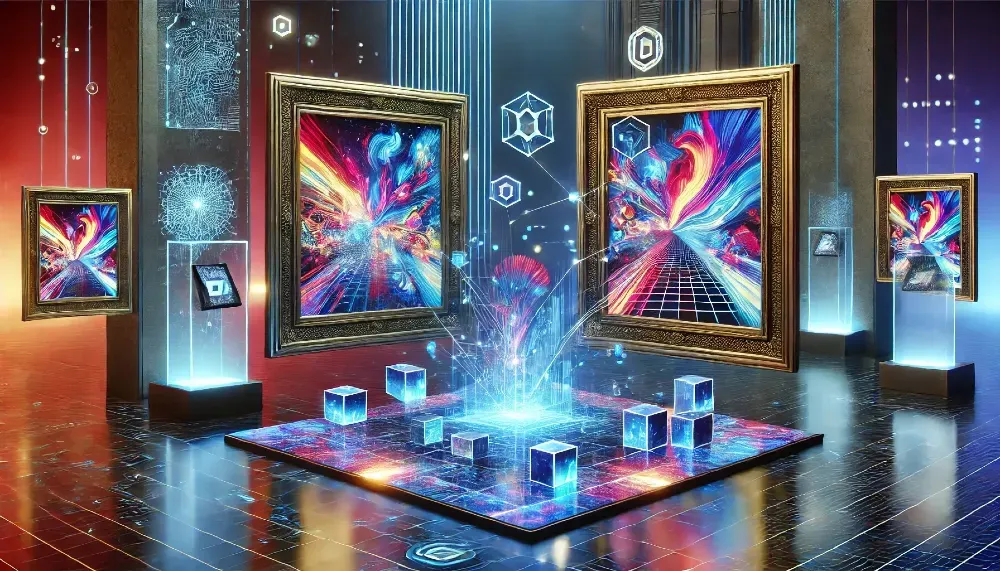NFT art has taken the digital world by storm, sparking excitement and debate in equal measure. This new form of creative expression combines art with blockchain technology, offering unique opportunities for artists and collectors alike.

NFT art is a digital asset that represents ownership of a unique piece of artwork on the blockchain. It can take many forms, including images, videos, or audio files. Unlike traditional digital files that can be easily copied, NFTs provide verifiable scarcity and ownership through the use of smart contracts.
The rise of NFT art has opened up new avenues for creators to monetize their work and for collectors to own pieces of digital history. Platforms like OpenSea have emerged as popular marketplaces for buying, selling, and trading these digital assets. As the NFT art scene continues to evolve, it raises questions about the nature of ownership in the digital age and the future of art itself.
Understanding NFTs
NFTs are unique digital assets that represent ownership of specific items or content on the blockchain. They have changed how we think about digital property and value.
Defining Non-Fungible Tokens
Non-Fungible Tokens (NFTs) are one-of-a-kind digital assets. Each NFT has a distinct value and can't be exchanged equally for another.
NFTs use blockchain technology to prove ownership and authenticity. They can represent digital art, music, videos, or even real-world items.
The key feature of NFTs is their uniqueness. This sets them apart from cryptocurrencies like Bitcoin, which are fungible and can be traded equally.
History and Evolution of NFTs
NFTs first appeared in 2014 with the creation of "Colored Coins" on the Bitcoin blockchain. These early tokens laid the groundwork for future NFTs.
In 2017, the CryptoKitties game on Ethereum sparked wider interest in NFTs. Users could buy, sell, and breed digital cats, each with unique traits.
Since then, NFTs have grown rapidly. They've been used for digital art, virtual real estate, and even tweets.
The NFT market exploded in 2021, with some pieces selling for millions of dollars. This boom brought NFTs into mainstream awareness.
The Role of Blockchain in NFTs
Blockchain technology is crucial for NFTs. It provides a secure, transparent way to track ownership and transactions.
Most NFTs use the Ethereum blockchain. Ethereum's smart contracts allow for complex rules and royalties to be built into NFTs.
When an NFT is created or "minted," its information is stored on the blockchain. This includes details about the creator, owner, and transaction history.
Blockchain ensures that each NFT is unique and can't be copied or faked. It creates scarcity in the digital world, which drives value.
NFTs vs. Traditional Digital Assets
NFTs differ from traditional digital assets in key ways. Regular digital files can be copied endlessly, while NFTs have verifiable scarcity.
Ownership of NFTs is clear and provable. With traditional digital assets, it's often hard to prove who owns or created something.
NFTs can include "smart contracts" that give creators ongoing royalties. This isn't possible with most digital assets.
The value of NFTs comes from their uniqueness and provenance. Traditional digital assets usually don't have these qualities.
The Intersection of NFT Art and Artists
NFT art has transformed how artists create, sell, and profit from their work. It blends technology with creativity in new ways.
Impact on Artists and the Creative Process
NFT art gives artists more control over their work. They can sell directly to buyers without galleries or agents. This cuts out middlemen and increases profits.
Artists now think about digital scarcity when creating. They must decide how many copies of a work to make as NFTs. This affects the value and rarity of each piece.
NFTs allow artists to get paid when their art is resold. Smart contracts can give the creator a percentage of future sales. This ongoing income is new for many artists.
Case Study: Prominent Digital Artists
Beeple's $69 million NFT sale showed the potential of digital art. His piece "Everydays: The First 5000 Days" set records at Christie's auction house.
Other artists like Pak and Mad Dog Jones have also found success. They create unique digital artworks that push creative boundaries.
These artists use new tools and techniques. 3D modeling, generative art, and AI are common in NFT creation. This expands what's possible in digital art.
Collaboration Between Traditional and Digital Artists
NFTs are bringing together artists from different backgrounds. Traditional painters are working with digital artists on new projects.
Some collaborations mix physical and digital elements. A painting might have a digital twin as an NFT. This creates unique experiences for art buyers.
NFTs also let traditional artists reach new markets. They can make digital versions of their physical works. This opens up their art to global online audiences.
NFT Market Dynamics

The NFT art market is shaped by several key factors that influence buying, selling, and valuation. These include the unique characteristics of digital art marketplaces, pricing mechanisms, and volatility in the crypto space.
Understanding the Art Market for NFTs
NFTs have created a new paradigm for digital art ownership and trading. Unlike traditional art, NFT artworks exist on the blockchain, usually Ethereum. This allows for verifiable scarcity and provenance.
The NFT art market attracts both crypto enthusiasts and traditional art collectors. It offers artists direct access to global buyers without intermediaries.
NFT art sales can range from a few dollars to millions. High-profile sales have included Beeple's $69 million artwork and CryptoPunks selling for millions each.
The market is still young and evolving rapidly. New artists and styles emerge frequently, keeping the space dynamic and unpredictable.
NFT Marketplaces and Platforms
Several platforms dominate the NFT art market. OpenSea is the largest, offering a wide range of NFTs including art, collectibles, and gaming items.
Other popular marketplaces include:
- Rarible: Known for its creator-centric approach
- Foundation: Focuses on high-quality curated art
- SuperRare: Emphasizes one-of-one digital artworks
- Nifty Gateway: Features drops from well-known artists
Each platform has unique features, fees, and user experiences. Some cater to specific niches or art styles.
Art Blocks, for instance, specializes in generative art NFTs. It allows artists to create algorithmic artworks minted on-demand.
Price Determinants and Market Volatility
NFT art prices are influenced by various factors:
- Artist's reputation and previous sales
- The rarity and uniqueness of the piece
- Current crypto market conditions
- Media attention and celebrity endorsements
The market can be highly volatile. Prices may fluctuate dramatically in short periods. This volatility is partly due to the speculative nature of the NFT market.
Liquidity can vary greatly between different NFTs. Some popular collections trade frequently, while others may have limited buyers.
External factors like regulatory changes or shifts in the broader crypto market can also impact NFT art prices.
Ownership and Transactions in the NFT Space

NFTs have changed how we think about owning digital art. They let people buy, sell, and trade unique digital items using blockchain technology.
The Concept of Digital Ownership
NFTs represent ownership of digital art or media. Each NFT is a unique token on the blockchain. This token proves who owns the artwork.
NFT owners can keep their art in a digital wallet. These wallets store the NFT safely on the blockchain.
Owning an NFT doesn't always mean owning a copyright. The artist may keep those rights. NFT owners get a certificate of ownership for their digital item.
Smart Contracts and NFT Sales
Smart contracts manage NFT sales. These are programs on the blockchain that run automatically.
When someone buys an NFT, the smart contract:
- Transfers ownership to the buyer
- Sends payment to the seller
- Updates the blockchain record
Smart contracts also set rules for future sales. They can include royalties for the original artist.
NFT Aftermarket – Secondary Sales and Royalties
After the first sale, NFTs can be resold. This is called the secondary market.
Many NFT platforms allow artists to earn royalties from these resales. The smart contract handles this automatically.
Royalties are usually a percentage of the sale price. They give artists ongoing income from their work.
The NFT's transaction history is public on the blockchain. This creates a clear record of ownership over time.
Future Outlook and Challenges of NFTs

NFTs are evolving rapidly, bringing new opportunities and hurdles. The digital art world is expanding, but environmental and legal issues need attention.
Innovative Trends in NFTs
Generative art and AI-generated pieces are gaining traction in the NFT space. Artists use algorithms to create unique works, blending technology and creativity.
Virtual reality and augmented reality are enhancing NFT experiences. Collectors can display their digital art in virtual galleries or overlay it onto real-world environments.
The metaverse is becoming a hub for NFT activity. Digital identities and virtual real estate are emerging as valuable assets. Fashion brands are creating virtual clothing and accessories as NFTs.
Addressing Environmental Concerns
The energy consumption of blockchain networks, especially Ethereum, has raised environmental concerns. NFT minting and transactions contribute to this issue.
Ethereum's shift to a proof-of-stake model aims to reduce energy use significantly. Other eco-friendly blockchain alternatives are emerging for NFT creation.
Artists and platforms are exploring carbon offset programs. Some are donating portions of NFT sales to environmental causes.
Legal and Ethical Considerations
Copyright infringement is a growing concern in the NFT market. Verifying ownership and authenticity of digital assets remains challenging.
Regulatory frameworks for NFTs are still developing. Tax implications and securities laws are areas of uncertainty.
Ethical questions arise around the value and ownership of digital art. The concept of scarcity in the digital realm continues to be debated.
Market manipulation and insider trading risks exist. Transparency in NFT marketplaces is crucial for maintaining trust.
Thank you for visiting our site and being part of this journey with us! We rely on the generous support of visitors like you to continue providing high-quality. Your donation, no matter the size, helps us maintain the website and create more valuable resources for everyone.


